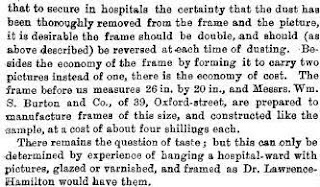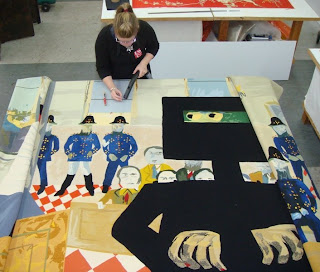





 We frequently find ourselves working on unusual items. Recently, our textiles conservator was asked to treat this tram roll by a private collector. It had developed black mould staining and orange-brown iron staining whilst in storage.
We frequently find ourselves working on unusual items. Recently, our textiles conservator was asked to treat this tram roll by a private collector. It had developed black mould staining and orange-brown iron staining whilst in storage. Because the tram roll was fabric, and the ink used to colour it was water-soluble (and thus we could not use water-based solutions for cleaning), the treatment was quite difficult. Whilst we were able to remove a substantial amount of general soiling, and reduce the visibility of both the mould and the iron stains, in this instance it was not possible to totally remove the stains.
Because the tram roll was fabric, and the ink used to colour it was water-soluble (and thus we could not use water-based solutions for cleaning), the treatment was quite difficult. Whilst we were able to remove a substantial amount of general soiling, and reduce the visibility of both the mould and the iron stains, in this instance it was not possible to totally remove the stains. It was interesting timing for us, because one of our other clients, the Historic Houses Trust of NSW is currently staging an exhibition called Shooting Through: Sydney by Tram at the Museum of Sydney. Associated with this exhibition are a variety of events, including an interesting seminar on 25 September, "Nostalgia vs Reality: are trams the answer?", exploring the potential for trams to solve Sydney's transport woes.
It was interesting timing for us, because one of our other clients, the Historic Houses Trust of NSW is currently staging an exhibition called Shooting Through: Sydney by Tram at the Museum of Sydney. Associated with this exhibition are a variety of events, including an interesting seminar on 25 September, "Nostalgia vs Reality: are trams the answer?", exploring the potential for trams to solve Sydney's transport woes.



 In May 2008, ICS Senior Objects Conservator Karina Acton provided specialist conservation advice to the Dig International team during this excavation. This site is best known as the site of the Ned Kelly siege in 1880.
In May 2008, ICS Senior Objects Conservator Karina Acton provided specialist conservation advice to the Dig International team during this excavation. This site is best known as the site of the Ned Kelly siege in 1880. The excavation discovered a fascinating variety of artefacts and remains of the Ann Jones Inn, and you can find out more this Thursday 9 July at 8.30pm on ABC television when "Ned Kelly Uncovered", hosted by Tony Robinson of "Time Team" fame, goes to air.
The excavation discovered a fascinating variety of artefacts and remains of the Ann Jones Inn, and you can find out more this Thursday 9 July at 8.30pm on ABC television when "Ned Kelly Uncovered", hosted by Tony Robinson of "Time Team" fame, goes to air.  "The tiled floor in red and white was in a house I was in once. The courthouse was in South Melbourne and through the left-hand window you can see sailing ships of the time. The candelabra is true to life. The judge wears the black cloth of death and below is a sergeant with a rolled, sealed document that seals doom for Kelly. Of course, it could not have been ready. Kelly told Judge Barry that he would soon see him in the next world, which is not a very polite thing to say to a man who's just sentenced you to death. Strangely enough, Mr Justice Barry, a great man, who did many good deeds, went home to bed and died a fortnight later, from, it is said, a septic carbuncle."
"The tiled floor in red and white was in a house I was in once. The courthouse was in South Melbourne and through the left-hand window you can see sailing ships of the time. The candelabra is true to life. The judge wears the black cloth of death and below is a sergeant with a rolled, sealed document that seals doom for Kelly. Of course, it could not have been ready. Kelly told Judge Barry that he would soon see him in the next world, which is not a very polite thing to say to a man who's just sentenced you to death. Strangely enough, Mr Justice Barry, a great man, who did many good deeds, went home to bed and died a fortnight later, from, it is said, a septic carbuncle."

 needles from a haystack), and localised solvent cleaning. This approach is resulting in a substantial improvement in the condition of the tapestry.
needles from a haystack), and localised solvent cleaning. This approach is resulting in a substantial improvement in the condition of the tapestry.Tomorrow is the One Day of the Year. And in the run up to Anzac Day, it is interesting to reflect on the representation of war memorials and war memorabilia in our workload at International Conservation Services.
This week, our conservators have been carrying out conservation treatments on:

The Cenotaph in Martin Place, Sydney, in preparation for the Dawn Service to be held there from 4.30am on Anzac Day
A selection of war diaries kept by naval personnel
Several naval ensigns
But in the course of the past year, we have also treated such disparate items as:
Japanese military swords acquired by a private individual at the time of the Japanese surrender in WWII
WWII anti-aircraft Bofors gun currently located in Redfern Park
A German WWI Minenwerfer trench mortar owned by a Queensland local government authority
And we have undertaken other projects associated with war memorials or military sites including:









 Currently known as the “Grissell Building”, in acknowledgement of the original manufacturers, Henry Grissell of London, this prefabricated industrial structure was discovered on the ACI site at Alexandria. Following documentation in 1997 by Godden Mackay Logan, the Grissell building was dismantled and stored on the site for ten years. In late 2007, we were awarded a contract by Meriton Apartments to conserve all of the elements so that the building could be re-erected in a park in the centre of the site.
Currently known as the “Grissell Building”, in acknowledgement of the original manufacturers, Henry Grissell of London, this prefabricated industrial structure was discovered on the ACI site at Alexandria. Following documentation in 1997 by Godden Mackay Logan, the Grissell building was dismantled and stored on the site for ten years. In late 2007, we were awarded a contract by Meriton Apartments to conserve all of the elements so that the building could be re-erected in a park in the centre of the site.



Drop in and enjoy the delicate tracery of 19thC cast and wrought iron work sometime.
David West
International Conservation Services
